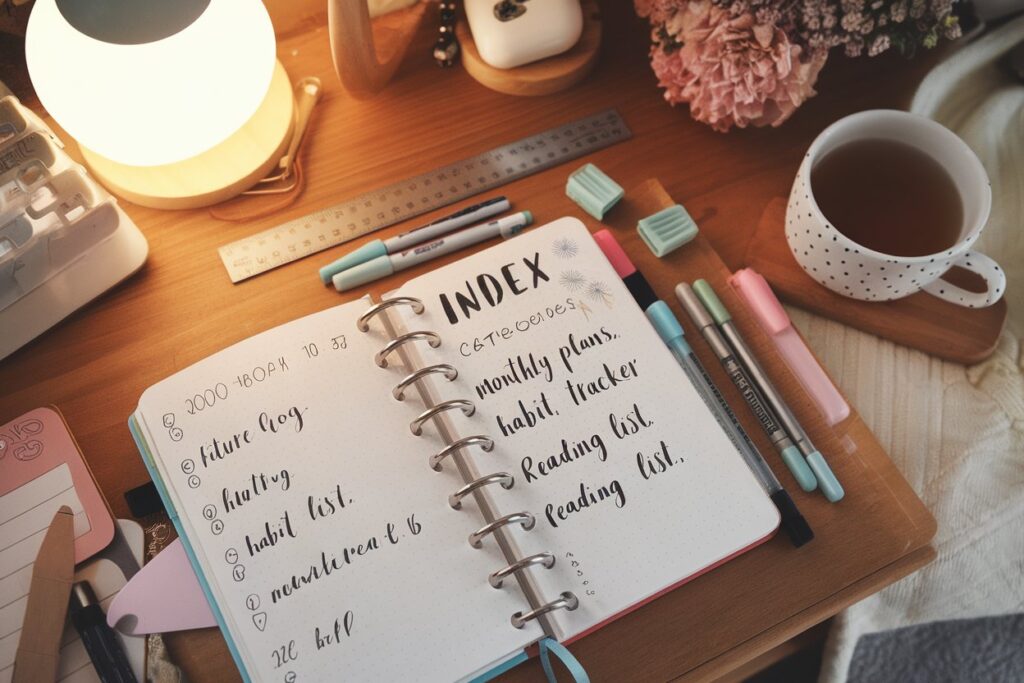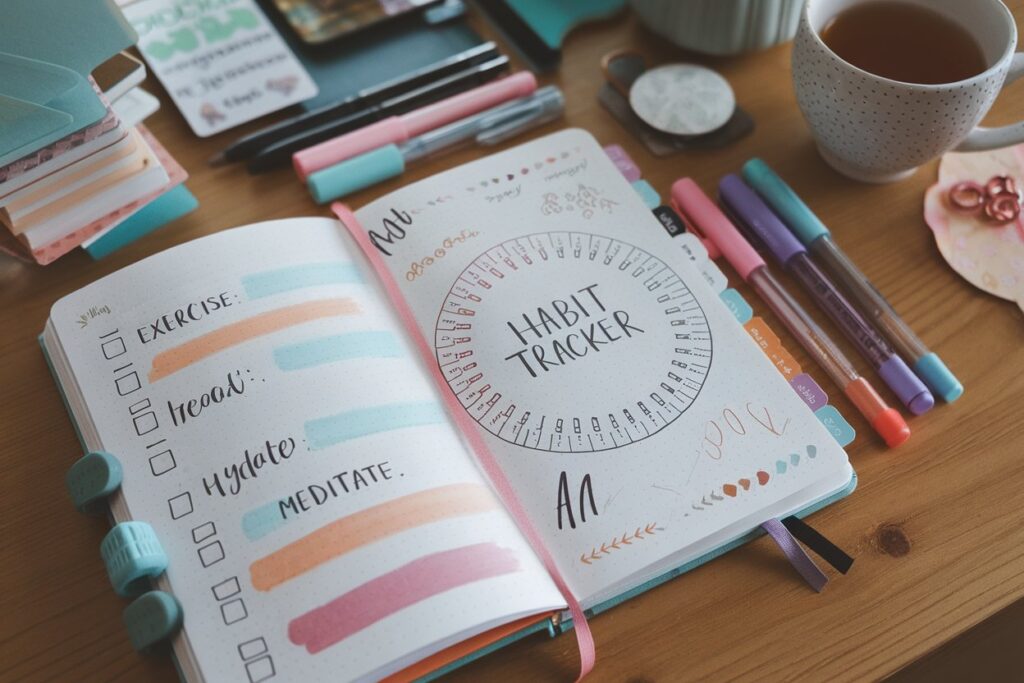Discover the transformative power of bullet journaling in this comprehensive guide. Learn how to set up your first journal, master rapid logging, and customize collections to organize your life and boost productivity.
Have you ever found yourself drowning in a sea of scattered to-do lists, forgotten appointments, and half-completed projects? I certainly have. Three years ago, my desk was a graveyard of abandoned planners, and my phone was cluttered with multiple productivity apps—none of which seemed to stick. Then, I discovered bullet journaling, and everything changed.
This simple analog system has transformed not just how I organize my tasks but also how I approach my goals, track my habits, and even manage my mental health. And I’m not alone—millions worldwide have embraced this flexible planning method that requires nothing more than a notebook and a pen to get started.
In this comprehensive guide, I’ll walk you through everything you need to know about bullet journaling—from basic setup to advanced techniques—so you can create a system that perfectly fits your unique life.
Let’s dive in!
Table of Contents
- What Is Bullet Journaling?
- Getting Started: The Essential Supplies
- Setting Up Your First Bullet Journal
- Mastering Rapid Logging
- Creating Effective Collections
- Bullet Journal Ideas for Students
- Minimalist vs. Artistic Approaches
- Bullet Journaling for Mental Health
- Advanced Techniques and Hacks
- Digital Integration Options
- Troubleshooting Common Challenges
- Conclusion: Your Bullet Journal Journey
What Is Bullet Journaling?
Bullet journaling is a customizable organization system created by Ryder Carroll, a digital product designer who was looking for a solution to his own organizational challenges. It’s called a “bullet” journal because it uses different bullet symbols to categorize and prioritize information.
At its core, bullet journaling is an analog system that combines your to-do list, planner, notebook, and diary into one streamlined notebook. It helps you track the past, organize the present, and plan for the future.
Why Is It Called a Bullet Journal?
The name comes from the bullet point symbols used throughout the system. These bullets act as visual cues that help you quickly process and prioritize information. Different types of bullets represent different types of entries:
- • (dot) for tasks
- ○ (circle) for events
- “-” (dash) for notes

What Are the Core Components of a Bullet Journal?
A traditional bullet journal consists of four main components:
- Index: Works like a table of contents, helping you find information quickly
- Collections: Different types of logs and lists that organize your information
- Rapid Logging: A method of quickly capturing information using bullets and symbols
- Migration: The process of moving unfinished tasks forward to stay organized
The beauty of this system is its flexibility—while these components form the foundation, you can adapt and evolve them to suit your specific needs.
“The bullet journal is meant to be your friend. There are no bullet journal police that are going to come and arrest you if you don’t use it as intended.” – Ryder Carroll
Getting Started: The Essential Supplies
One of the most appealing aspects of bullet journaling is its accessibility—you don’t need expensive equipment to begin. Here’s what you’ll need:
The Basics:
- A Notebook – Any notebook will do, but some features make bullet journaling easier:
- Dotted pages (helpful for creating layouts but not essential)
- Numbered pages (saves time with indexing)
- Thick paper (prevents bleeding if you use markers)
- A built-in bookmark (helps you find your current page)
- A Pen – Choose something that feels comfortable for everyday writing
That’s it! You can start with just these two items and expand your supplies as you discover what works for you.
Popular Notebook Options:
| Notebook | Features | Price Range | Best For |
|---|---|---|---|
| Official Bullet Journal | Pre-printed index, dotted pages, 3 bookmarks | $20-25 | Traditionalists who want the original experience |
| Leuchtturm1917 A5 | Numbered pages, dotted option, index pages | $18-22 | All-around solid choice for beginners |
| Archer & Olive | 160 GSM paper (ultra thick), dotted pages | $30-35 | Artists who use heavy markers/watercolors |
| Scribbles That Matter | Thick paper, comes with pen loop | $15-20 | Those who want durability at a mid-range price |
| Lemome | Thick paper, pocket, expandable inner pocket | $12-15 | Budget-conscious beginners |
While premium journals offer nice features, remember that any notebook can become a bullet journal. I started with a $1 composition book, and it worked perfectly fine!

Optional Supplies for Customization:
If you want to get creative with your bullet journal, consider:
- Colored pens (Staedtler Triplus Fineliners or Micron pens are popular)
- Highlighters for emphasis
- Washi tape for decoration and color coding
- Ruler for clean lines
- Stencils for consistent layouts
- Correction tape for mistakes
A word of caution: don’t get caught in the trap of thinking you need all these supplies to start. The most important thing is to begin with what you have.
Setting Up Your First Bullet Journal
Starting a bullet journal might seem intimidating, but breaking it down into simple steps makes it manageable. Let’s walk through the process:
When Can I Start a Bullet Journal?
You can start a bullet journal at any time of the year. Unlike pre-printed planners, you create pages as you need them, so there’s no wrong time to begin. Many people start fresh in January or with a new academic year, but I started mine in the middle of October, and it worked out perfectly.
Step 1: Create an Index
The first few pages of your journal should be reserved for your index. This will help you locate specific collections as your journal fills up.
Simply label these pages “Index” and leave them mostly blank to fill in as you go. You’ll add page numbers and topics as you create new sections in your journal.

Step 2: Set Up a Future Log
The future log is a calendar that gives you a bird’s-eye view of the coming months. It helps you plan ahead and keep track of important dates.
To create a basic future log:
- Dedicate 2-4 pages to this section
- Divide the pages into sections for each month you want to include (typically 6-12 months)
- Label each section with the month name
- Add known events, deadlines, and commitments
Step 3: Create a Monthly Log
Your monthly log provides a more detailed view of the current month. A traditional monthly log consists of:
- Calendar Page: A list of dates down the left side of the page with days of the week noted
- Task Page: A space to record monthly tasks and goals

Step 4: Start Your Daily Log
The daily log is where bullet journaling truly shines. It’s flexible, adaptable, and perfect for daily use:
- Write the date at the top of the page
- Add tasks, events, and notes throughout the day using the appropriate bullets
- Create a new daily log each day, using as much or as little space as you need
Remember, there’s no need to create daily logs in advance—that’s the beauty of the system! You use exactly the space you need each day.
Mastering Rapid Logging
What Is Rapid Logging?
Rapid logging is the language of bullet journaling—a method of capturing information quickly and efficiently using bullets and short phrases instead of complete sentences.
Think of it as note-taking for your life. It’s designed to help you record information with minimal effort and maximum clarity.
Using Bullets and Signifiers
The basic bullets we covered earlier (•, ○, -) are just the beginning. You can also use signifiers—additional symbols that add context to your entries:
- * (asterisk) = Priority
- ! (exclamation) = Inspiration
- 👁️ (eye) = Needs research
- ❤️ (heart) = Personal favorite
You can create your own signifiers based on what information you want to highlight. The key is consistency—stick with the same symbols so they become second nature.
Task Migration: Keeping Things Current
Task migration is a crucial practice that prevents your bullet journal from becoming just another abandoned to-do list. Here’s how it works:
- At the end of each day or week, review uncompleted tasks
- For each task, decide:
- Is it still relevant? Mark it as complete (×) or irrelevant (strike through)
- Does it need to be done soon? Migrate (>) it to your daily or weekly log
- Is it for the future? Migrate it to your future log (»)
Migration might seem tedious, but it serves an important purpose: it forces you to reconsider each task’s value before copying it over. This extra friction helps eliminate tasks that aren’t truly important.
Creating Effective Collections
Collections are the heart of bullet journaling—they’re where you gather related information in one place.
Standard Collections
Some collections form the backbone of the bullet journal system:
- Index: Your table of contents
- Future Log: Your long-term calendar
- Monthly Log: Your month at a glance
- Daily Log: Your day-to-day tasks and notes
Custom Collections
The real magic happens when you create collections that address your specific needs. Some popular examples include:
- Habit Tracker: Monitor daily habits with a simple grid
- Mood Tracker: Track your emotional well-being over time
- Goal Setting Pages: Break down big goals into actionable steps
- Reading List: Keep track of books you want to read
- Project Planner: Organize complex projects into manageable tasks
- Meal Planner: Plan your meals for the week
- Exercise Log: Track your workouts and progress

The key to successful collections is making them work for you—not creating them because you saw them on Instagram. Always ask: “Will this collection help me achieve my goals or solve a problem?”
Bullet Journal Ideas for Students
As a student, your bullet journal can be a powerful tool for managing your academic life. Here are some student-specific collections to consider:
Academic Calendar Spread
Create a semester overview that includes:
- Important dates (exams, assignment deadlines, registration periods)
- Class schedule
- Study group meetings
- Office hours

Class-Specific Collections
For each course, consider creating:
- Assignment tracker with due dates
- Reading log with pages/chapters and completion dates
- Project timelines broken down into milestones
- Grade tracker to monitor your progress
Study Planning Collections
Optimize your study time with:
- Pomodoro tracker (25-minute focus sessions)
- Subject rotation schedule
- Revision timetable for exam periods
- Concept maps for complex topics
Budget Tracking for Students
Manage your finances with:
- Monthly budget spread
- Expense tracker
- Savings goals for textbooks or other large purchases
- Financial aid and scholarship deadlines
One student I know created a “textbook exchange” collection where she tracked books she needed, their prices at different sources, and potential swap opportunities with other students—it saved her hundreds of dollars!
Minimalist vs. Artistic Approaches
There are two main schools of thought in bullet journaling: minimalist and artistic. Both are equally valid—the right approach is the one that works for you.
The Minimalist Approach
Minimalist bullet journaling focuses on function over form, emphasizing:
- Simple layouts
- Monochrome or limited color palettes
- Efficient use of space
- Quick setup time
Benefits of minimalism:
- Takes less time to maintain
- Keeps focus on content rather than decoration
- Less pressure to create “perfect” pages
- Works well with limited supplies

The Artistic Approach
Artistic bullet journaling embraces creativity, featuring:
- Elaborate themes and color schemes
- Hand lettering and illustrations
- Decorative elements like washi tape and stickers
- More complex layouts
Benefits of artistic journaling:
- Serves as a creative outlet
- Can make planning more enjoyable
- Creates a beautiful keepsake
- Combines productivity with self-expression

Finding Your Balance
Most bullet journalists fall somewhere between these extremes. You might use a minimalist approach for busy weeks and get more creative when time allows. Or you might keep functional pages simple while dedicating more time to collections that inspire you.
Remember: The effectiveness of your bullet journal isn’t measured by how pretty it looks but by how well it helps you organize your life.
Bullet Journaling for Mental Health
Beyond organization, many people discover that bullet journaling becomes a powerful tool for managing mental health.
Mood Tracking
Mood trackers help you identify patterns in your emotional well-being:
- Daily mood logs using colors or symbols
- Factors that influence your mood (sleep, exercise, social interaction)
- Treatment tracking if applicable

Gratitude Logging
Practicing gratitude has well-documented mental health benefits:
- Daily gratitude entries (3-5 things you’re grateful for)
- Gratitude prompts for inspiration
- Positive experience records
Self-Care Planning
Intentional self-care is crucial for mental health:
- Self-care activity ideas
- Daily or weekly self-care checklists
- Energy accounting (activities that drain vs. replenish you)
Therapy Support Tools
If you’re in therapy, your bullet journal can complement your work:
- Thought records for cognitive behavioral therapy
- Trigger tracking
- Coping strategy lists
- Questions or topics to discuss in your next session
One particularly effective page I’ve used is a “feelings wheel” collection—when I’m struggling to identify emotions, I can turn to this page and find the right words to describe what I’m experiencing.
Advanced Techniques and Hacks
Once you’re comfortable with the basics, try these advanced bullet journaling techniques:
Dutch Door Method
Create a “door” in your journal by cutting partial pages that allow you to see multiple spreads at once—perfect for referencing weekly information alongside daily logs.
Threading
When collections become spread throughout your journal, use “threading” to connect them:
- Note the current page number in your index
- When you continue the collection elsewhere, add the new page number
- On the original page, note where the collection continues
- On the continuation page, note where it came from
Color Coding Systems
Develop a consistent color system for different areas of your life:
- Work (blue)
- Personal (green)
- Health (red)
- Finance (yellow)
- Social (purple)
Rapid Logging Shorthand
Create your own abbreviated language to make rapid logging even faster:
- mtg = meeting
- w/ = with
- f/u = follow up
- WIP = work in progress
Time Blocking
Transform your daily log into a time-blocked schedule by:
- Drawing a timeline down the margin
- Blocking out committed time (meetings, classes)
- Allocating time blocks for tasks and projects
Digital Integration Options
While bullet journaling is primarily an analog system, many practitioners integrate digital tools:
Can I Use Digital Tools Alongside a Bullet Journal?
Absolutely! Digital and analog systems can complement each other perfectly. Here are some effective combinations:
- Use your digital calendar for appointments and your bullet journal for tasks
- Take meeting notes digitally but plan your day in your journal
- Scan completed journal pages for digital backup
- Use task management apps for collaborative projects and your journal for personal work
Digital Bullet Journal Options
If you prefer typing to writing, consider these digital alternatives:
- Note-taking apps like Notion or Evernote
- Digital planning apps with templates (GoodNotes, Notability)
- Microsoft OneNote with custom bullet journal templates
While these options offer searchability and easy backup, many find that the physical act of writing in a paper journal helps with memory retention and provides a break from screen time.
Troubleshooting Common Challenges
Even experienced bullet journalists encounter obstacles. Here are solutions to common problems:
“I don’t have time to set up elaborate spreads.”
Solution: Embrace minimalism. A simple list of dates and a task list work perfectly fine.
“I’m afraid of making mistakes”.
Solution: Accept imperfection as part of the process. Use correction tape if needed, or simply cross out mistakes and move on.
“I can’t stick with it consistently.”
Solution: Build journaling into your daily routine, perhaps with morning coffee or before bed. And remember—if you miss a day or week, just start again where you left off.
“My handwriting isn’t nice enough.”
Solution: Your journal is for you, not Instagram. Focus on legibility, not beauty. Your handwriting will likely improve with practice anyway.
“I keep abandoning collections.”
Solution: Start with just the essential collections. Add new ones only when you identify a specific need, not because they look cool online.
Conclusion: Your Bullet Journal Journey
A bullet journal is more than just a planning system—it’s a reflection of your life, evolving as you do. The pages you fill become a record of your journey, documenting not just what you did, but what mattered to you.
Whether you’re a student managing classes, a professional juggling projects, or someone simply trying to bring more intention to daily life, bullet journaling offers a flexible framework that can adapt to your needs.
The most important thing to remember is that there’s no right or wrong way to bullet journal. It’s about creating a system that works for you, not adhering to someone else’s aesthetic or rules.
So grab a notebook, pick up a pen, and start with a simple index and daily log. Your future self will thank you for the clarity, focus, and mindfulness this simple practice brings to your life.
Ready to Start Your Bullet Journal?
Take the first step today:
- Gather your basic supplies (notebook and pen)
- Set up your index
- Create your future log
- Start today’s daily log
Remember, the perfect time to begin is right now—not when you have the perfect supplies or when the new year starts. Your bullet journal journey begins with a single page.
What aspect of bullet journaling are you most excited to try? The organizational benefits? The creative outlet? The mindfulness practice? Whatever draws you to this system, embrace it and make it your own.




